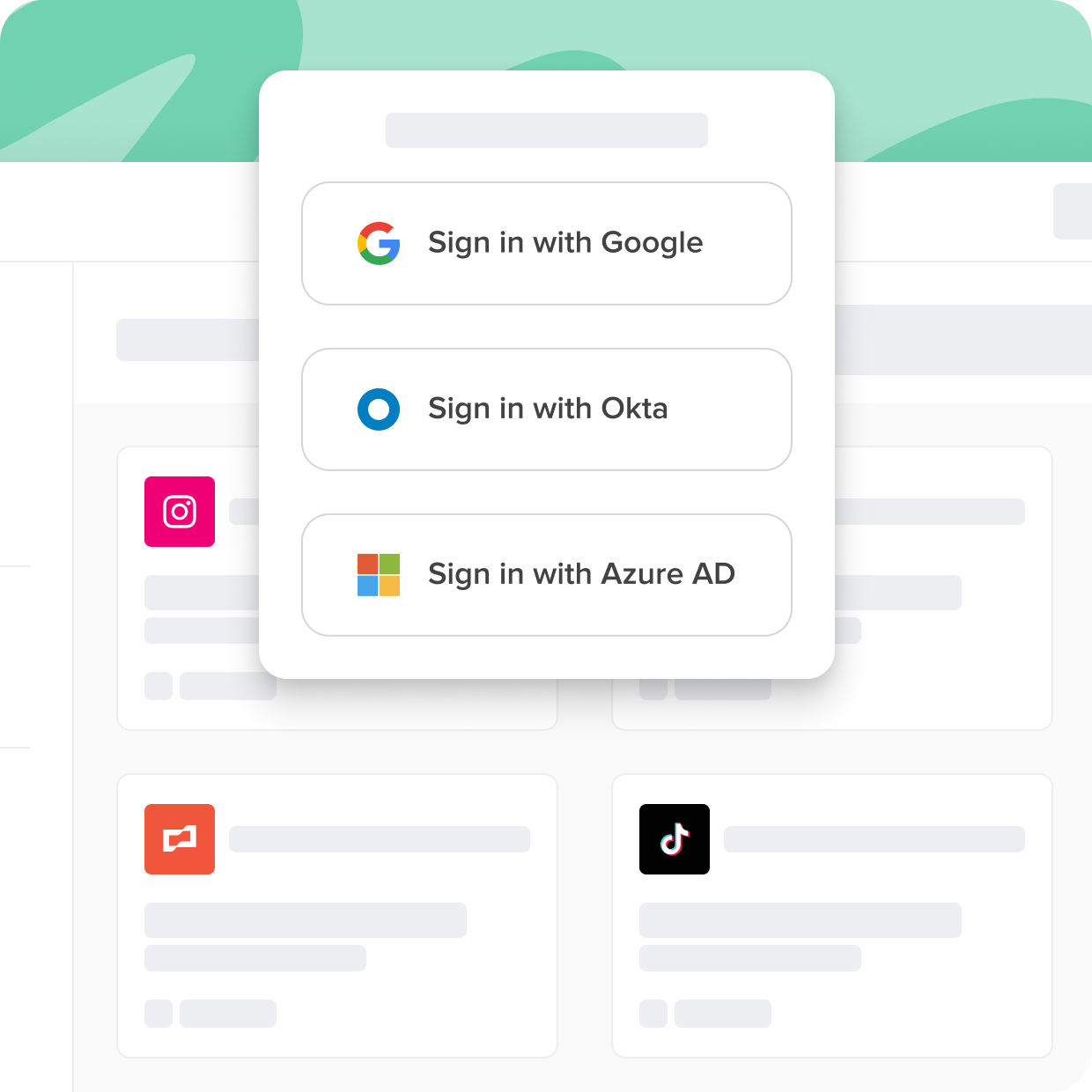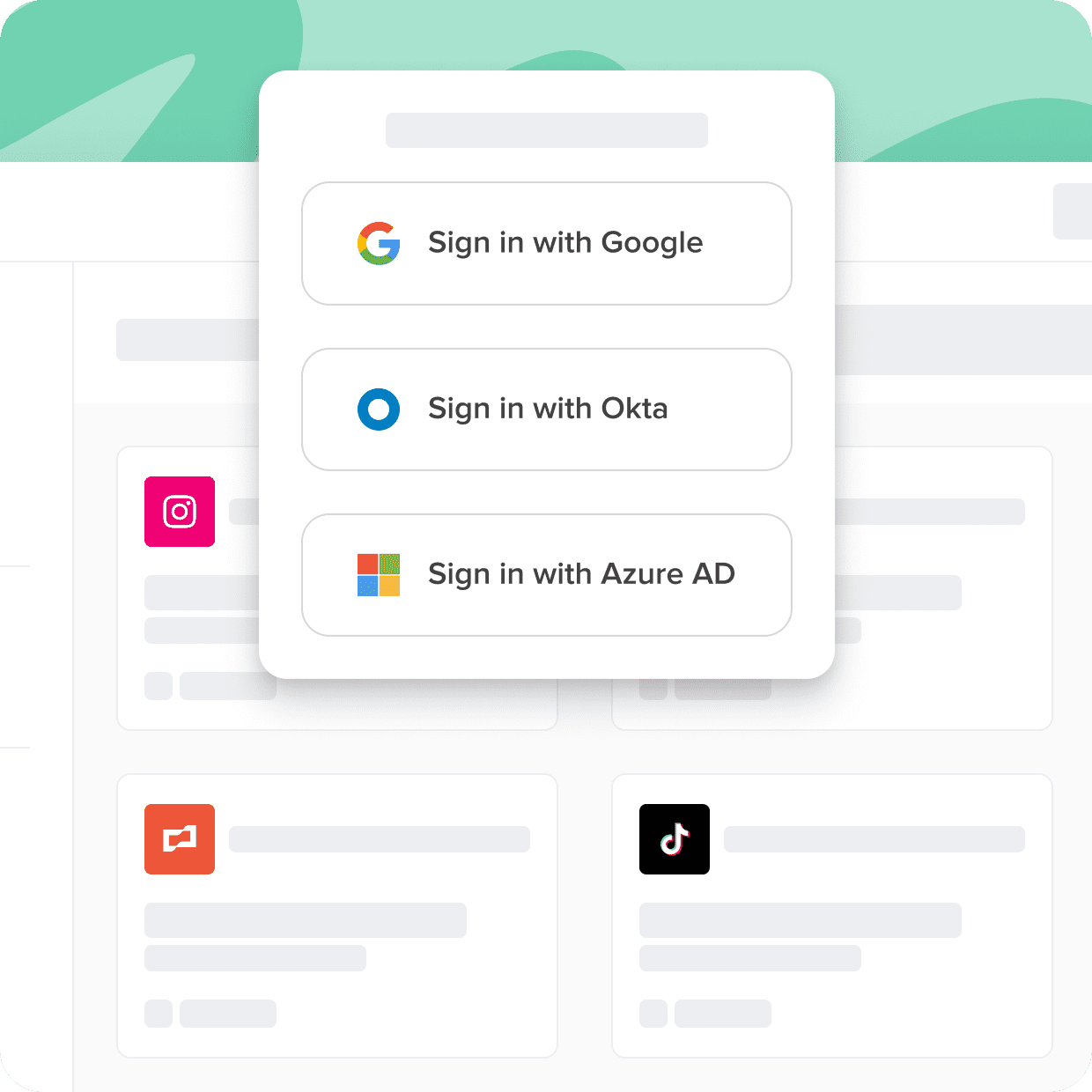SAML security is a crucial element of modern web applications tasked with providing seamless and secure access to their users. SAML is a standard protocol that facilitates secure authentication and authorization between different systems. It is commonly used in SSO implementations.
Unfortunately, many corporate applications don't support the SSO standard and can't reap all the benefits. The applications that fall into this category are best called "nonfederated." Nonfederated applications are a new category that is becoming increasingly challenging for businesses to manage and secure effectively, yet increasingly critical for businesses to succeed.
Cerby connects all your apps to your SSO tools, even if they don't support the SSO standard. In this guide, you'll learn about different SSO tools, the challenges, and the players.
Streamline Access With Single Sign-On
Not all apps are created equal. Some come with security gaps and complexities that can hinder user adoption and put sensitive data at risk. With Cerby, you can ensure secure and seamless access to all your applications, regardless of their support for standards like SSO.
With Cerby You Can

Close the identity gap

Universally enforce 2FA

Eliminate the SSO tax
SAML Security
SAML security is a crucial element of modern web applications tasked with providing seamless and secure access to their users. But what is SAML, and what does it do? The SAML, Security Assertion Markup Language, is an XML-based standard for exchanging authentication and authorization data between parties, particularly between an identity provider (IdP) and a service provider (SP).
With the increased reliance on cloud-based services and the need for easy access to multiple applications, SAML has gained relevance in recent years. As an open standard, SAML allows web applications to securely share identity information with third-party identity providers. It enables single sign-on (SSO), the ability for users to authenticate themselves once and then access multiple related applications without the need for further authentication. This reduces the risk of password-related security issues.
What is SAML authentication? SAML authentication is the process of verifying a user's identity using SAML assertions. An assertion is a package of information that an IdP sends to an SP that contains details about the authenticated user. The SP then relies on this assertion to grant the user access to its resources. The SAML authentication process typically involves three parties: the user (also known as the principal), the IdP, and the SP.
SAML IdP
The SAML protocol consists of users, IdPs, and SPs. The SAML IdP is responsible for authenticating users and issuing SAML assertions, while the SP relies on these assertions to grant users access to their resources.
The SAML authentication process can be broken down into the following steps:
- Initial request: First, the user requests access to a protected resource on the SP. Since the user has not yet been authenticated, the SP generates a SAML request, often referred to as the SAML AuthnRequest, to initiate the authentication process. A standard SAML request example typically contains a unique identifier, timestamp, and the intended destination (the SAML IdP).
- Redirect to IdP: The SP then sends the SAML request to the user's browser, which automatically redirects the user to the SAML IdP's SSO endpoint.
- User authentication: Upon receiving the SAML request, the SAML IdP authenticates the user. This authentication can be performed using methods like MFA and social login mechanisms.
- Generation of SAML assertion: After successful authentication, the SAML IdP creates a SAML assertion or an XML document containing the user's identity, authentication details, and other relevant attributes. This assertion serves as proof that the user has been authenticated by the IdP.
- SAML response: The SAML IdP embeds the SAML assertion within a SAML response. The SAML response includes additional information to ensure the integrity and authenticity of the message. This response is then sent back to the user's browser.
- Redirect to SP: The user's browser automatically redirects the user back to the SP's Assertion Consumer Service (ACS) endpoint, along with the SAML response. The SP then validates the SAML response.
- Access granted: If the SAML response is valid, the SP extracts the SAML assertion and uses the information contained within to grant the user access to the requested resource.
Viewing a SAML request and response example can be helpful in understanding the seamless and secure exchange of information between the IdP and SP.
SAML vs. OAuth
SAML, OAuth, OpenID Connect, JWT, and LDAP are authentication protocols used for various purposes in web applications. Understanding the difference between them is crucial for choosing the right one for each use case.
- SAML vs OpenID: SAML (Security Assertion Markup Language) is an XML-based standard for exchanging authentication and authorization data between parties, mainly between an IdP and an SP. OpenID, on the other hand, is a decentralized authentication protocol that allows users to utilize a single digital identity across multiple websites.
- SAML vs OIDC: OpenID Connect (OIDC) is an authentication layer built on top of the OAuth 2.0 protocol. It uses JSON Web Tokens (JWT) for identity assertions, unlike SAML, which uses XML.
- SAML vs OAuth: OAuth is an authorization protocol where users don't have to share credentials to get third-party applications access to their resources. OAuth is often used in scenarios where users delegate access to their data hosted on different platforms. While SAML focuses on user authentication and SSO, OAuth is centered on securing API access between applications.
- SAML vs LDAP: LDAP (Lightweight Directory Access Protocol) is a protocol for accessing and maintaining distributed directory information services, primarily used for user and group management. Unlike SAML, LDAP is not specifically designed for authentication, although it can be used for that purpose.
- SAML vs JWT: JSON Web Token (JWT) is a compact, URL-safe means of representing claims to be transferred between two parties. JWTs can be used for authentication and authorization, and they form the basis of OIDC. SAML and JWT both convey user identity information, but they differ in their formats (XML for SAML and JSON for JWT) and use cases.
SAML SSO
SAML SSO offers numerous benefits to organizations and users alike. It not only streamlines the user experience but enhances security and simplifies user management. One of the main benefits of SAML SSO is that it allows users to authenticate once and access multiple related applications without needing to re-enter their credentials. This improves the user experience by reducing the time and effort required to access applications.
Understanding SAML vs SSO, however, is important when working in this domain, as the two can be easily confused. SAML is a standard that enables SSO by facilitating the exchange of authentication and authorization information between parties. SSO is a broader concept that refers to the ability for users to authenticate once and access multiple applications.
The SAML SSO process typically involves the following steps:
- The user requests access to a protected resource on an SP.
- The SP generates a SAML authentication request and redirects the user to the IdP.
- The IdP authenticates the user using various methods, such as username and password or MFA.
- Upon successful authentication, the IdP creates a SAML assertion.
- The IdP then embeds the assertion within a SAML token.
- The user's browser sends the SAML token back to the SP, which validates the token and grants the user access to the requested resource.
SAML Okta
Choosing the right SAML solution can be easier said than done, but by thoroughly comparing all options, businesses can find the tools that are right for their specific needs. SAML providers deliver comprehensive platforms that simplify user authentication, authorization, and SSO across various applications. Studying each SAML identity provider and what they offer is key to selecting the most ideal solution.
Auth0 SAML tools support a wide range of identity protocols. Auth0 enables developers to easily integrate SAML SSO for their applications, acting as both a SAML IdP and a service provider SP. Auth0 provides a user-friendly dashboard, SDKs, and APIs that streamline the process of configuring and managing SAML integrations with various applications.
Okta is another leading identity and access management platform specializing in providing seamless, scalable SSO solutions. As a SAML identity provider, Okta simplifies the process of integrating SSO across various applications. It supports a wide range of pre-built integrations with popular applications, making it easy for organizations to set up and manage SAML SSO. SAML Okta tools also come with advanced features like adaptive MFA and user provisioning.
Azure Active Directory (Azure AD) is Microsoft's cloud-based identity and access management service, which supports SAML as one of its primary authentication protocols. Azure AD provides a comprehensive platform for managing user identities and more across both Microsoft and third-party applications. With SAML Azure tools, organizations can seamlessly integrate SAML SSO with thousands of popular applications available in the Azure AD app gallery.
Each of these SAML providers offers unique advantages and features:
- Auth0 (owned by Okta) is well-suited for developers and organizations looking for a customizable, extensible authentication and authorization platform with support for various identity protocols.
- Okta is ideal for enterprises seeking a user-friendly platform that simplifies SSO, user management, and access control across multiple applications.
- Azure Active Directory is an excellent choice for organizations already invested in the Microsoft ecosystem, as it provides seamless integration with Microsoft applications and services while also supporting a wide range of third-party applications
According to the Ponemon Institute, to manage nonfederated applications, its recommended to centralize nonfederated application management by implementing solutions that bridge the gap between your organization’s IdP and these applications across all categories. Assign security and/or identity teams to manage access, as business units may not adhere to security best practices, contributing to potential cybersecurity incidents.
Cerby is another great solution for access management. It mitigates risk by incorporating all nonfederated applications into the identity lifecycle of users’ existing workforce identity platforms, including Okta and Azure AD.
SAML Authentication Example
Maintaining secure SAML authentication and authorization in web applications involves adhering to best practices and recommendations. These practices ensure that the SAML 2.0 protocol, defined by the OASIS Security Services Technical Committee, is utilized effectively. Here’s how businesses can stay on track:
- Use the latest version: Always use the most recent version of the SAML 2.0 protocol, as it includes enhancements and security improvements over previous versions.
- Encrypt sensitive data: Protect sensitive information within SAML assertions, such as personally identifiable information (PII), by using encryption. This ensures data confidentiality during transmission between IdP and SP.
- Secure communication: Use secure communication channels to transmit SAML authentication messages and assertions, preventing unauthorized access or tampering.
- Validate and sanitize input: To prevent XML-based attacks, validate and sanitize input. See a SAML XML example for a better understanding of how this process works.
Following these best practices is critical to ensuring adherence to the SAML 2.0 protocol. By incorporating these guidelines, businesses can facilitate easy, secure authentication and keep operations flowing smoothly. It can also be helpful to view a SAML authentication example prior to implementation.


